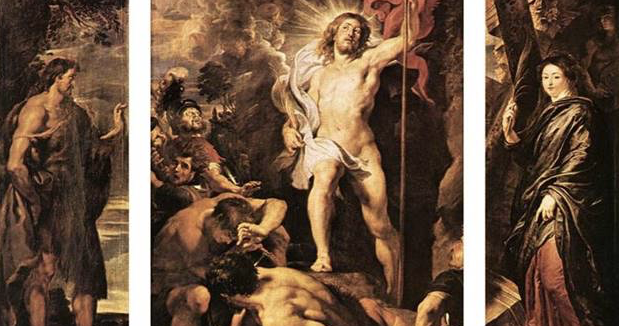(From the insightful weekly blog of www.artway.eu edited by Marleen Hengelaar, and written this week by David Lyle Jeffrey, Distinguished Professor of Literature and the Humanities at Baylor University and Guest Professor of Peking University.)
“CHRIST IS RISEN! HE IS RISEN INDEED! ALLELUIA!”
With such hymns and liturgical exclamations, worshippers on this most important day of the Christian year rejoice with one another, celebrating the world-changing event of the Resurrection of Christ Jesus from the tomb, two days after his degrading, tortuous death on the cross and burial.
Hardly any other event in the gospels ought so powerfully to attract visual artists; yet the frequency of depiction of the Resurrection pales into quite modest comparison with the countless images of his terrible death, or even of the removal of his body from the cross and deposition in the tomb.
(For) the Resurrection is the true climax of the gospel narratives and apex of the gospel message, without which, as St. Paul so famously said, our faith is in vain (1 Corinthians 15:13-14).
None of the gospels actually depict the moment; they tell us rather of his body’s absence from the tomb when the women first, then Peter, came. There is a gap. Consequently, artists have been obliged to imagine how the very first witnesses, the guards at the tomb (Matthew 28), may have reacted when and if they saw Jesus actually bursting forth from behind the sealed stone. This is the conjecture Piero della Francesco and Mantegna depict with more conventional iconography. In their depictions the risen Christ emerges serenely victorious from a sarcophagus, banner of his triumph over sin and death in his hand, with the tomb guards as ineffectual spectators.
Terrible beauty
Peter Paul Rubens goes far beyond any of these paintings in realism and raw power. His resurrected Christ literally bursts forth from a rough and rocky hillside tomb like a young Hercules about to do battle (compare with Rubens’ Drunken Hercules, painted just a year earlier). We see a massive, vigorous, fully corporeal yet divinized body. The radiant beams emanating from his head (no longer wounded, marks in his forward foot and side barely visible) may be an allusion to the young bridegroom as the sun of Psalm 19:5-6, a poetic image borrowed from the Babylonian myth of the Sun-god, already employed in an allegory for Christ’s resurrection in the famous Utrecht Psalter. But most of all we recognize the influence of Michelangelo, who used just such an allusion for his drawing of the Resurrection (1532, British Museum), a study for his controversial Sistine Chapel Last Judgment, a work which Rubens had seen and greatly admired. The Jesus of his 1612 Resurrection of Christ explicitly resembles Michelangelo’s suddenly appearing Judge of All. There is nothing serene whatsoever about this image of the resurrected Christ. His is a terrible beauty.
In the midst of our joyful Easter celebrations, splendid traditional hymns and colorful array, it may be that we miss the kinetic power of the risen Christ. He is not conformable to our well-dressed niceties, simply because he is far too strong, and much too real. John Updike captures the discomfiting scandal of the Resurrection well enough for our time when he writes,
Make no mistake: if he rose at all
it was as His body;
if the cells dissolution did not reverse, the molecules
reknit, the amino acids rekindle,
the Church will fall.
(Seven Stanzas at Easter, 1964)
For some, the Resurrection can seem like a judgment on unbelief. For others, such as Rubens’ English contemporary the poet and priest John Donne, it is the pre-eminent ground of faith. Donne connects the Resurrection to the Judgment of God in a manner Rubens’ painting seems equally to affirm, reminding us that what must appear as a terror to those who do not know him in the power of his Resurrection is for those who do, conversely, an assurance of eternal hope:
…If in thy little booke my name thou enroule,
Flesh in that long sleep is not putrified.
But made that there, of which, and for which t’was;
Nor can by other means be glorified.
May then sinnes sleep, and deaths soone from me passe,
That wak’t from both, I again risen may
Salute the last, and everlasting day.
(Holy Sonnet 6, ca. 1615)
Rubens’ resurrected Lord is glorious, but far from manageable. That, Rubens suggests, ought to be a source of abiding Christian comfort. He is a great God and a mighty King above all gods.
Christ is risen! Alleluia!
—–
Peter Paul Rubens: Triptych with the Resurrection of Christ, 1611-12, oil on panel, 178 x 138 cm. Rubens (1577-1640) is the most eminent of northern Baroque painters, sometimes called “the prince of the Counter-Reformation artists”.
Till next week,




